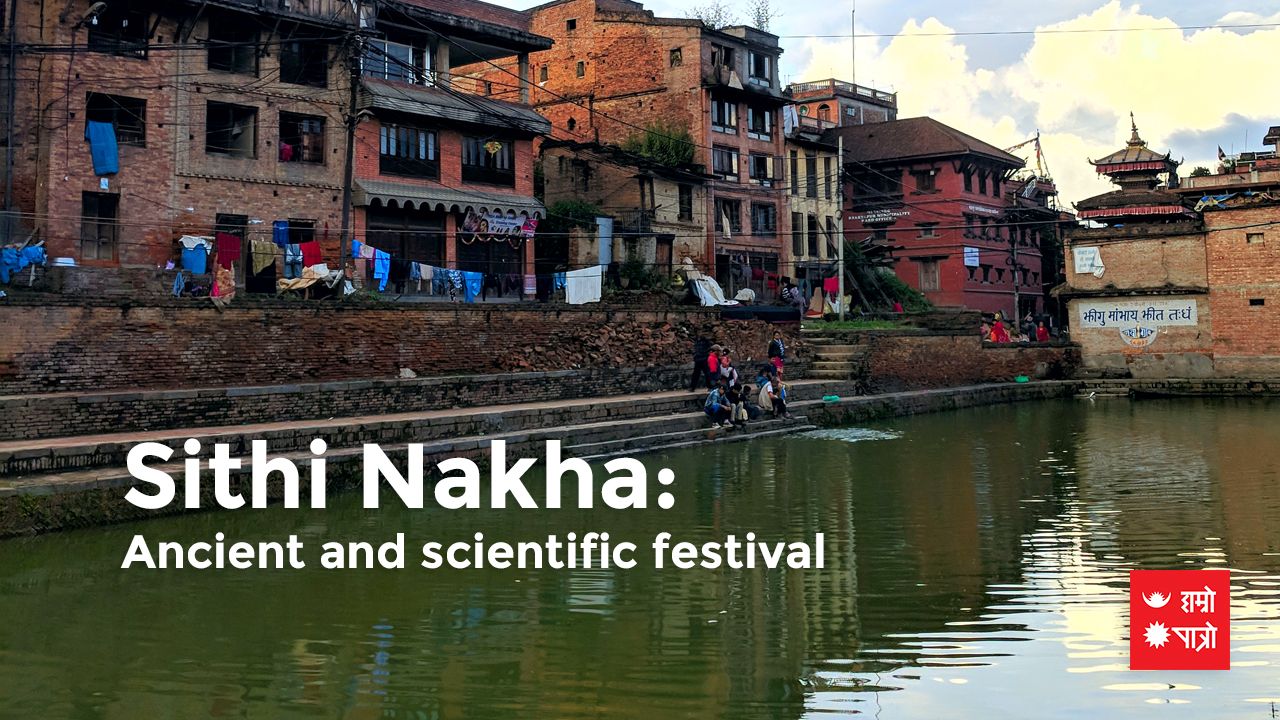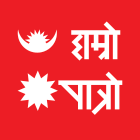Upcomming Events
-
27Paush
-
29PaushNational Bhakka Day 2 days remaning
-
30PaushShattila Ekadashi 3 days remaning
-
1MaghMakar Sankranti/Ghiu chaku khane Din/Uttarayan Arambha 4 days remaning
-
2MaghNational Earthquake Safety Day/Pradosh Vrata 5 days remaning
-
5MaghSonam Lhochhar/Shree Ballav Jayanti 8 days remaning
-
8MaghTilkunda Chauthi 11 days remaning
-
9MaghBasanta Panchami vrata/Saraswati Pooja 12 days remaning
-
10MaghSkanda Sasti/Achala Saptami/International Day of Education 13 days remaning
-
11MaghGorakhkali Puja/World Leprosy Day 14 days remaning
-
12MaghInternational Custom Day 15 days remaning
-
13MaghDron Nawami 16 days remaning
-
15MaghBhima Ekadashi Vrata 18 days remaning
-
16MaghSahid Diwas/Pradosh Vrata 19 days remaning
-
18MaghShree Swasthani Brata Samapti/Poornima Wrata 21 days remaning
-
19MaghWorld Wetlands Day 22 days remaning
-
21MaghWorld Cancer Day 24 days remaning
-
25MaghRavisaptami Vrata 28 days remaning
-
26MaghGorakhkali Puja 29 days remaning
-
28MaghInternational Day of Women and Girls in Science/Safer Internet Day 31 days remaning
-
1FalgunKumbha Sankranti/Bijaya Ekadashi Vrata/World Radio Day 33 days remaning
-
2FalgunShani Pradosh Vrata/Valentine's Day 34 days remaning
-
3FalgunMaha-Shivaratri / Army Day/Silachahre Puja 35 days remaning
-
6FalgunGyalpo Lhosar 38 days remaning
-
7FalgunPrajatantra Diwas / Election Day 39 days remaning
-
8FalgunWorld Day of Social Justice 40 days remaning
-
9FalgunInternational Mother Language Day 41 days remaning
-
12FalgunBhaumashtami Wrata/Gorakhkali Puja 44 days remaning
-
15FalgunAmalaki Ekadashi Vrata/World NGO Day 47 days remaning
-
17FalgunPradosh Vrata/Zero Discrimination Day 49 days remaning
-
18FalgunFagu Poornima / Holi/Poornima Vrata 50 days remaning
-
19FalgunFagu Poornima (Terai)/Khandagras Chandra Grahan/World Wildlife Day 51 days remaning
-
20FalgunTel Lagaune Ra Aapko Mujura Khane Din 52 days remaning
-
24FalgunInternational Womens Day 56 days remaning
-
27FalgunGorakhkali Puja 59 days remaning
-
1ChaitraMeen Sankranti/Paapmochini Ekadashi Brata/World Consumer Rights Day 63 days remaning
-
2ChaitraSom Pradosh Vrata 64 days remaning
-
3ChaitraPahachahre 65 days remaning
-
4ChaitraGhode Jaatra 66 days remaning
-
5ChaitraTel Lagaune Ra Nimko Pat Khane Din 67 days remaning
Jyotish
-
Jyotish Amrit Paudelवाराणसीकै सम्पूर्णानन्द संस्...
-
Jyotish Vaman Sapkotaशिक्षा - व्याकरणाचार्य, पौरोही...
-
Jyotish Pandit Mukunda Nepalज्योतिष पण्डित मुकुन्द नेपाल�...
-
Jyotish Narayan Prasad Gautamगुरुकुल शिक्षा प्रणालीबाट ज्�...
-
Jyotish Purushottam Ghimireनेपाल संस्कृत विश्वविद्यालय, �...
-
Jyotish Damodar Kaushikज्योतिष र व्याकरण विषयमा आचार�...
-
Jyotish Mohan Ghimireसम्पुर्णानन्द संस्कृत विश्वव...
-
Jyotish Damodar Poudelनेपाल संस्कृत विश्व बिद्यालय�...
-
Jyotish Krishna Prasad Bhandariउपप्राध्यापक (Asst. professor of Sanskrit) नेपा�...
-
 Jyotish Dharmendra Krishna Paudelशास्त्री धर्मेन्द्र कृष्ण पौ�...
Jyotish Dharmendra Krishna Paudelशास्त्री धर्मेन्द्र कृष्ण पौ�...
-
Jyotish Dipendra Khatiwadaसम्पुर्णानन्द संस्कृत बिश्वब...
-
Jyotish Khageshwor Subediगुरुकुल पद्दति बाट ज्योतिषीय �...
-
Jyotish Narayan Prasad Bhandariज्योतिषका उप-प्राध्यापक (lecturer of A...
-
Jyotish Smarika Acharyaबाल्मीकि बिद्यापिठ बाट ज्योत�...
-
Jyotish Hamro patroनेपाल संस्कृत विश्वविद्यालय �...
-
 Jyotish Mukunda Sharmaस्वाध्याय, सत्सङ्ग र सदाचारजस�...
Jyotish Mukunda Sharmaस्वाध्याय, सत्सङ्ग र सदाचारजस�...
-
 Jyotish Kuresh Pandey११ वर्षको अनुभवसहित विभिन्न ध�...
Jyotish Kuresh Pandey११ वर्षको अनुभवसहित विभिन्न ध�...
-
Jyotish Deepak Prasad Kafleसम्पूर्णानन्द संस्कृत विश्वव...
-
Jyotish Ghanashyam Pokharelनेपाल संस्कृत विश्वविद्यालयब...
Hororscope
Sithi Nakha । World Day Against Child Labour

Sithi Nakha Nepal Samvat 1144: ancient and scientific festival.
According to the Newa civilization and rites, the Sithi Nakha festival is celebrated every year on the day of Jeshtha Shukla Sashti.Just as Kathmandu is popular as a city of temples, so is Kathmandu a city of pottery and ponds, wells, stone fountains, and boreholes. Considering the cleanliness and orderliness of these things which are very important for water resources, it has become a custom to celebrate Sithi Nakh. Today, the importance of Sithi Nakha to Kathmandu and Kathmandu residents has increased even more.
Highlights of Sithi Nakha
This festival also highlights the importance of water source conservation and the need for clean water. Today, it is customary to worship around wells, boreholes, and ponds and to clean up before worship. In this way, after everyone has gathered and worshiped, the far-reaching ritual of being religiously and culturally compelled not to litter there throughout the year is commendable.
It is believed that the water resource should be closed for a few days after cleaning in Sithi Nakha to stabilize the water level. When water is cleaned, it is cleaned by entering inside the dug wells, ponds, and boreholes, and by doing so, the underneath wastes like mud, silt, and sediment come up to the surface of the water. After cleaning the spring in this way, milk, ghee, honey, curd, and other things are added there. There is a fact that the water source in the Kathmandu valley is not as clean and full as before, resources have degraded because of rapid urbanization and mismanaged constructions/ habitat.No matter how much rain falls, there is a cement floor around it, so the water source will not be able to absorb the rain. Due to this, most of the water sources are drying up and the people of the valley have to depend on pipes, tankers, and jars for water.
Activities on Sithi Nakha
On the day of Sithi Nakha, after the collective cleaning of the water source, it is customary to go to each other's home to greet and the welcome is delivered also through offering traditional Newa food such as Bara, Chatamari, Choyala, etc. On the same day, Chandi Devi is worshiped at Chaskhel in Bhaktapur and Kumar Kartikeya (Son of Lord Shiva and Parwati) is worshipped at Jaisidebal Kathmandu. Kumar Kartikeya is referred to by the community as a picture of eight lotus flowers placed at the entrance of his house or an artistic expression carved in metal, the entrance of a traditional Newa home is decorated by such artistic metal lotus.
Want to talk a little bit about Kumar Kartikeya, this son of Shivaji is described in the Puranas as a colonel in a supernatural army, referred to as Mahasenani. This strong man, Kumar, who can kill demons like Tarakasur is also described as the son of Ganga. It is said in the Puranas that he had six heads and was on the banks of the Ganges at the time of his birth. The river Ganga itself flows through Shivaji's Jata, so the form of Ganga has a lot to do with the water and its purity.
A unique blend of environment, milieu, and lifestyle, this festival has been teaching us the lesson of water and spring sanitation for centuries. Public awareness programs are being run in the Nepali community through foreign projects, from hand washing to drinking clean water. If we look closely, our ancient traditions are scientific and transformative in themselves. Good luck to Sithi Nakh: May our water source and mind be both pure and clean.
World Day Against Child Labour
12 June marks the World Day Against Child Labour under the theme “Universal Social Protection to End Child Labour.” On this day, the ILO, together with its constituents and partners, is calling for increased investment in social protection systems and schemes to establish solid social protection floors and protect children from child labor.
While significant progress has been made in reducing child labor over the last two decades, progress has slowed over time, and it has even stalled during the period 2016-2020. At the beginning of 2020, 160 million children – 63 million girls and 97 million boys – were involved in child labor, accounting for almost 1 in 10 children worldwide.
Theme 2024:
Let's act on our commitments: End Child labor
Child Labor in Nepal
Though child labor is declining almost at the rate of 100,000 every year, Nepal still accounts for 1.1 million children between (5-17 years) in child labor. Of these 222,493 are estimated to be engaged in hazardous work. The agriculture sector accounts for more than 85% of the total child labor in Nepal.
Although child labor is declining at a rate of about one lakh per year, there are still 1.1 million child laborers (5 to 17 years) in Nepal. It is estimated that 222,493 of them are involved in hazardous work. Agriculture accounts for more than 85 percent of the total child labor in Nepal. Nepal signed the UN Convention on the Rights of the Child in 1990, expressing its commitment to the rights of the child, but its implementation has been weak.
Apart from this, Human Rights and Trafficking Control Act 2007, Civil Rights Act 1995, Children Act 1992, Child Labor Prohibition and Regular Act 2000, and Kamaiya Labor Act 2002 have ensured child rights in Nepal by making child labor illegal. May Nepal be able to eradicate child labor.
Meaningful wishes.
-Suyog Dhakal
Upcomming Events
-
27Paush
-
29PaushNational Bhakka Day 2 days remaning
-
30PaushShattila Ekadashi 3 days remaning
-
1MaghMakar Sankranti/Ghiu chaku khane Din/Uttarayan Arambha 4 days remaning
-
2MaghNational Earthquake Safety Day/Pradosh Vrata 5 days remaning
-
5MaghSonam Lhochhar/Shree Ballav Jayanti 8 days remaning
-
8MaghTilkunda Chauthi 11 days remaning
-
9MaghBasanta Panchami vrata/Saraswati Pooja 12 days remaning
-
10MaghSkanda Sasti/Achala Saptami/International Day of Education 13 days remaning
-
11MaghGorakhkali Puja/World Leprosy Day 14 days remaning
-
12MaghInternational Custom Day 15 days remaning
-
13MaghDron Nawami 16 days remaning
-
15MaghBhima Ekadashi Vrata 18 days remaning
-
16MaghSahid Diwas/Pradosh Vrata 19 days remaning
-
18MaghShree Swasthani Brata Samapti/Poornima Wrata 21 days remaning
-
19MaghWorld Wetlands Day 22 days remaning
-
21MaghWorld Cancer Day 24 days remaning
-
25MaghRavisaptami Vrata 28 days remaning
-
26MaghGorakhkali Puja 29 days remaning
-
28MaghInternational Day of Women and Girls in Science/Safer Internet Day 31 days remaning
-
1FalgunKumbha Sankranti/Bijaya Ekadashi Vrata/World Radio Day 33 days remaning
-
2FalgunShani Pradosh Vrata/Valentine's Day 34 days remaning
-
3FalgunMaha-Shivaratri / Army Day/Silachahre Puja 35 days remaning
-
6FalgunGyalpo Lhosar 38 days remaning
-
7FalgunPrajatantra Diwas / Election Day 39 days remaning
-
8FalgunWorld Day of Social Justice 40 days remaning
-
9FalgunInternational Mother Language Day 41 days remaning
-
12FalgunBhaumashtami Wrata/Gorakhkali Puja 44 days remaning
-
15FalgunAmalaki Ekadashi Vrata/World NGO Day 47 days remaning
-
17FalgunPradosh Vrata/Zero Discrimination Day 49 days remaning
-
18FalgunFagu Poornima / Holi/Poornima Vrata 50 days remaning
-
19FalgunFagu Poornima (Terai)/Khandagras Chandra Grahan/World Wildlife Day 51 days remaning
-
20FalgunTel Lagaune Ra Aapko Mujura Khane Din 52 days remaning
-
24FalgunInternational Womens Day 56 days remaning
-
27FalgunGorakhkali Puja 59 days remaning
-
1ChaitraMeen Sankranti/Paapmochini Ekadashi Brata/World Consumer Rights Day 63 days remaning
-
2ChaitraSom Pradosh Vrata 64 days remaning
-
3ChaitraPahachahre 65 days remaning
-
4ChaitraGhode Jaatra 66 days remaning
-
5ChaitraTel Lagaune Ra Nimko Pat Khane Din 67 days remaning
Jyotish
-
Jyotish Amrit Paudelवाराणसीकै सम्पूर्णानन्द संस्...
-
Jyotish Vaman Sapkotaशिक्षा - व्याकरणाचार्य, पौरोही...
-
Jyotish Pandit Mukunda Nepalज्योतिष पण्डित मुकुन्द नेपाल�...
-
Jyotish Narayan Prasad Gautamगुरुकुल शिक्षा प्रणालीबाट ज्�...
-
Jyotish Purushottam Ghimireनेपाल संस्कृत विश्वविद्यालय, �...
-
Jyotish Damodar Kaushikज्योतिष र व्याकरण विषयमा आचार�...
-
Jyotish Mohan Ghimireसम्पुर्णानन्द संस्कृत विश्वव...
-
Jyotish Damodar Poudelनेपाल संस्कृत विश्व बिद्यालय�...
-
Jyotish Krishna Prasad Bhandariउपप्राध्यापक (Asst. professor of Sanskrit) नेपा�...
-
 Jyotish Dharmendra Krishna Paudelशास्त्री धर्मेन्द्र कृष्ण पौ�...
Jyotish Dharmendra Krishna Paudelशास्त्री धर्मेन्द्र कृष्ण पौ�...
-
Jyotish Dipendra Khatiwadaसम्पुर्णानन्द संस्कृत बिश्वब...
-
Jyotish Khageshwor Subediगुरुकुल पद्दति बाट ज्योतिषीय �...
-
Jyotish Narayan Prasad Bhandariज्योतिषका उप-प्राध्यापक (lecturer of A...
-
Jyotish Smarika Acharyaबाल्मीकि बिद्यापिठ बाट ज्योत�...
-
Jyotish Hamro patroनेपाल संस्कृत विश्वविद्यालय �...
-
 Jyotish Mukunda Sharmaस्वाध्याय, सत्सङ्ग र सदाचारजस�...
Jyotish Mukunda Sharmaस्वाध्याय, सत्सङ्ग र सदाचारजस�...
-
 Jyotish Kuresh Pandey११ वर्षको अनुभवसहित विभिन्न ध�...
Jyotish Kuresh Pandey११ वर्षको अनुभवसहित विभिन्न ध�...
-
Jyotish Deepak Prasad Kafleसम्पूर्णानन्द संस्कृत विश्वव...
-
Jyotish Ghanashyam Pokharelनेपाल संस्कृत विश्वविद्यालयब...
Hororscope
Liked by:


















 Mesh
Mesh Brish
Brish Mithun
Mithun Karkat
Karkat  Singha
Singha  Kanya
Kanya Tula
Tula Brischik
Brischik Dhanu
Dhanu  Makar
Makar  Kumbha
Kumbha Meen
Meen